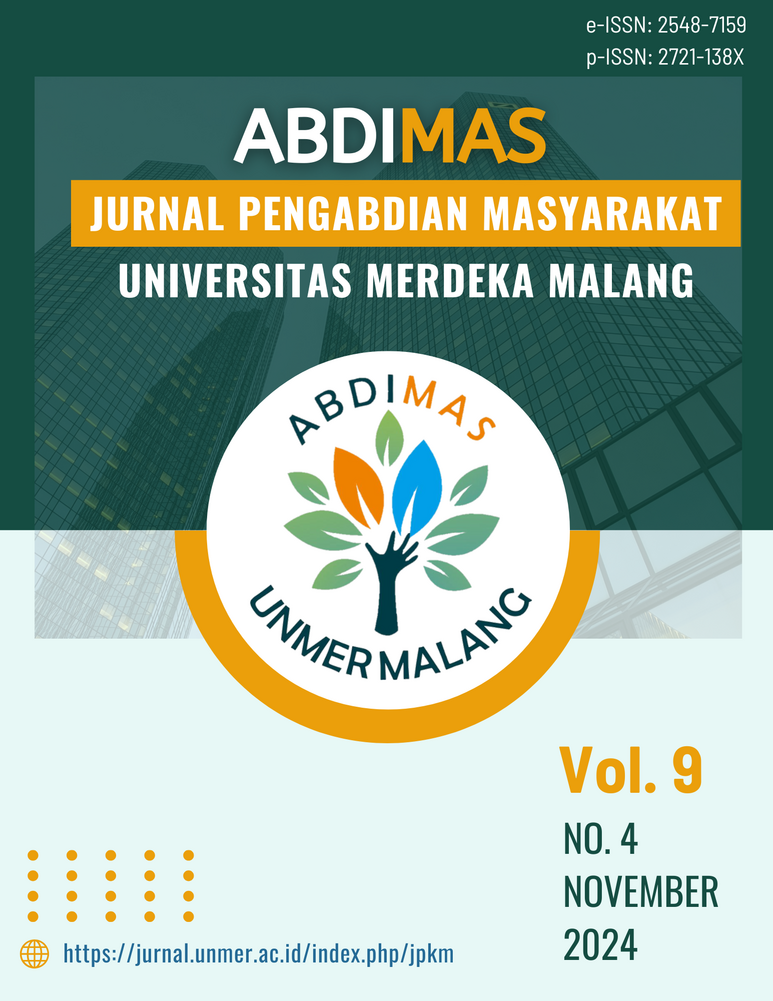Optimizing Batik MSMEs through the implementation of green economy and sustainable digitalization
DOI:
https://doi.org/10.26905/abdimas.v9i4.14086Keywords:
Batik, Environment, Green economy, MSMEs, SustainabilityAbstract
The Nona Alif Muclisin MSME in Pasuruan Regency faces challenges in the batik industry, particularly environmental pollution caused by synthetic dyes and limitations in global marketing. This community service program aims to address these challenges by applying green economy principles and digital marketing strategies. Through training sessions, the MSME was taught environmentally friendly waste management practices and the use of natural dyes to reduce pollution. Additionally, digital marketing training was provided to expand market reach and enhance the global visibility of batik products. The program also included tree planting initiatives as a source of natural dyes and an effort to mitigate environmental impacts. The results showed a significant reduction in environmental pollution through the adoption of natural dyes and improved waste management. The implementation of digital marketing strategies successfully expanded the MSME’s market and increased product sales. In conclusion, this program effectively addressed environmental and marketing challenges in batik MSMEs. However, continuous follow-up is needed to ensure the sustainability of positive outcomes and to support the future development of MSMEs.
Downloads
References
Harsanto, B., & Permana, C. T. (2020). Sustainability-oriented innovation (SOI) in the cultural village: an actor-network perspective in the case of Laweyan Batik Village. Journal of Cultural Heritage Management and Sustainable Development, 11(3), 297–311. https://doi.org/10.1108/jchmsd-08-2019-0102
Istirokhatun, T., Susanto, H., Budihardjo, M. A., Septiyani, E., Wibowo, A. R., & Karamah, E. F. (2021). Treatment of batik industry wastewater plant effluent using nanofiltration. International Journal of Technology, 12(4), 770. https://doi.org/10.14716/ijtech.v12i4.4645
Jones, T. (2018). International intangible cultural heritage policy in the neighbourhood: An assessment and case study of Indonesia. Journal of Cultural Geography, 35(3), 362–387. https://doi.org/10.1080/08873631.2018.1429351
Kasim, A. A., Bakri, M., Hendra, A., & Septriani, A. (2022). Spatial and topology feature extraction on batik pattern recognition: a review. Jurnal Informatika, 16(1), 1. https://doi.org/10.26555/jifo.v16i1.a25415
Krisnawati, E., Sunarni, N., Indrayani, L. M., Sofyan, A. N., & Nur, T. (2019). Identity exhibition in batik motifs of Ebeg and Pataruman. Sage Open, 9(2). https://doi.org/10.1177/2158244019846686
Levi, P. A., Hunga, A. I. R., & Sidabalok, H. (2021). Reviewing batik with natural coloring based on the clean production theory with an ecofeminist perspective (Case study: Putri Kawung Batik Community in Klaten). SALASIKA: Indonesian Journal of Gender, Women, Child, and Social Inclusion’s Studies, 4(1), 1–12. https://doi.org/10.36625/sj.v4i1.77
Nurjanah, M. K., Rahman, A., & Nurhadi, -. (2021). The preservation strategy of written batik as a cultural heritage (Case study of Gunawan Setiawan Batik in Kauman Batik Tourism Village, Solo–Central Java, Indonesia). Jurnal Ilmu Sosial Mamangan, 10(2), 60–69. https://doi.org/10.22202/mamangan.v10i2.4772
Nyamiati, R. D., Listiawati, V., & Ariyuda, G. (2023). Adsorption dye in batik wastewater using biomass adsorbent : a State of the art review. Formosa Journal of Applied Sciences, 2(12), 3521–3530. https://doi.org/10.55927/fjas.v2i12.7059
Peters, R., Ee, N., Peters, J., Booth, A., Mudway, I., & Anstey, K. J. (2019). Air pollution and dementia: A systematic review. Journal of Alzheimer’s Disease, 70(s1), S145–S163. https://doi.org/10.3233/jad-180631
Poon, S. (2020). Symbolic resistance: Tradition in batik transitions sustain beauty, cultural heritage and status in the era of modernity. World Journal of Social Science, 7(2), 1. https://doi.org/10.5430/wjss.v7n2p1
Rahmadyanti, E. (2020). Integrated system of biofilter and constructed wetland for sustainable batik industry. International Journal of Geomate, 18(70). https://doi.org/10.21660/2020.70.61681
Sediyono, E., Mahatma, T., & Hunga, I. (2018). Knowledge management of traditional batik in Central Java. International Journal of Engineering & Technology, 7(4.44), 143. https://doi.org/10.14419/ijet.v7i4.44.26970
Sianturi, C. E., Kiawati, E. S., Ningsih, E. C., Fitria, N. R., Nurjanah, N., & Kusuma, J. W. (2022). Ethnomathematics: Exploration of mathematics through a variety of Banten Batik Motifs. International Journal of Economy, Education and Entrepreneurship (IJE3), 2(1), 149–157. https://doi.org/10.53067/ije3.v2i1.54
Tangahu, B. V., Ningsih, D. A., Kurniawan, S. B., & Imron, M. F. (2019). Study of BOD and COD Removal in batik wastewater using Scirpus grossus and Iris pseudacorus with Intermittent Exposure System. Journal of Ecological Engineering, 20(5), 130–134. https://doi.org/10.12911/22998993/105357
Wang, C. (2018). Building a network for preserving intangible cultural heritage through education: A study of Indonesian batik. International Journal of Art & Design Education, 38(2), 398–415.
Downloads
Published
How to Cite
Issue
Section
License
Copyright (c) 2024 Abdimas: Jurnal Pengabdian Masyarakat Universitas Merdeka Malang

This work is licensed under a Creative Commons Attribution-ShareAlike 4.0 International License.
Authors who publish with this journal agree to the following terms:
- Copyright of the published articles will be transferred to the journal as the publisher of the manuscripts. Therefore, the author confirms that the copyright has been managed by the journal.
- Publisher of Abdimas: Jurnal Pengabdian Masyarakat Universitas Merdeka Malang is University of Merdeka Malang.
- The copyright follows Creative Commons Attribution-ShareAlike License (CC BY SA): This license allows to share, copy, and redistribute the material in any medium or format, adapt, remix, transform, and build upon the material, for any purpose, even commercially.





